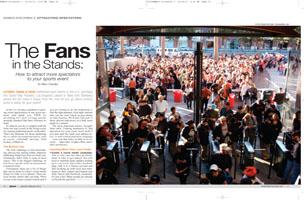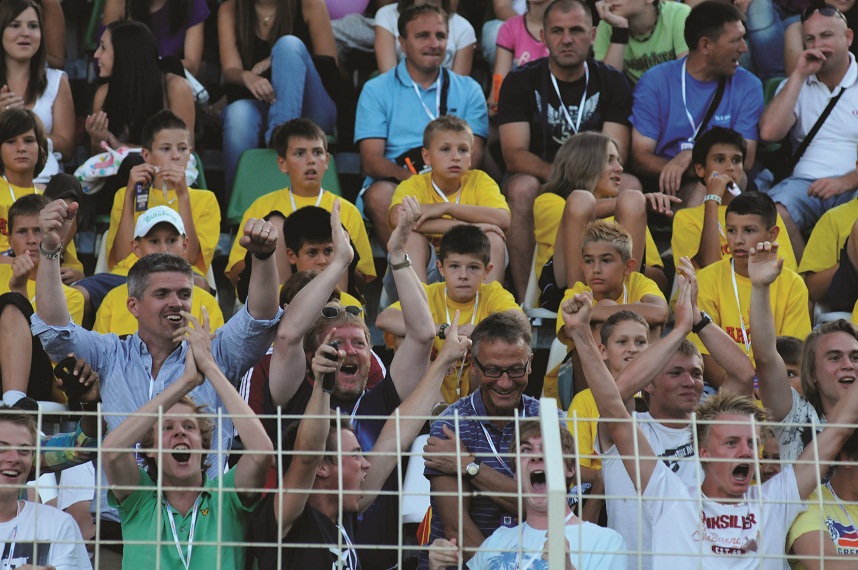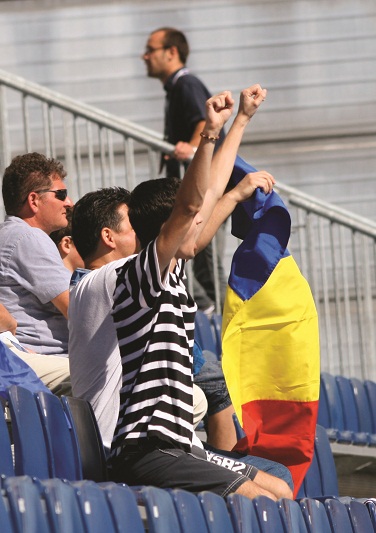
Other than a few traditional sport teams in the U.S. (perhaps the Green Bay Packers, Los Angeles Lakers or New York Yankees) where the fan base is larger than life, how do you go about putting butts in seats for your event?
In the U.S. we have a plethora of sporting event opportunities at any given moment (and thank you, ESPN for developing 24/7 sport coverage and the sporting channels that have followed its lead).
So what do you do to compete with the front row seat (couch in the living room) for viewing traditional sports on the tube? That’s the dilemma for those marketing the so called non-traditional sports, such as soccer, volleyball, lacrosse, field hockey, softball etc.
|
Eric Broder Van Dyke/Dreamstime.com |
The Bottom Line
The first challenge is first determining, and second, staying within, whatever marketing budget has been set aside (unfortunately, that’s little to none in most cases). This is the biggest challenge on how best to get the word out and promote a ticketed event.
Fortunately, there are a lot of things that can be done in today’s social media frenzy for little to no expense. There are local media outlets that can help, PSAs if your event meets certain criteria and if you are willing to do the homework to find the right partners, and local radio stations who can use your tickets as give-aways for their listeners. We’ll deal with each of these options (and more) in a little more depth in a minute.
The most important advice, though? Start early. Creating awareness of, and spectators for, your event, won’t work if you wait until the week your athletes arrive. A well-crafted awareness campaign — even one that relies on little to no income — takes time. It takes effort, and it takes persistence.
|
Peter Muzslay/Dreamstime.com |
Investing More Time, Less Funds
· Create a social media campaign: This is very easy but takes an investment of time to get started. You will need to maintain daily updates leading up to your event. Start with a Facebook page, link it to a Twitter account and start hooking up with local area businesses so they connect and expand your daily Tweets and Facebook comments. It’s just a fact: Many people are already on Facebook and more are finding Twitter by accident through their Facebook and LinkedIn accounts every day.
· Get it on the air: Use several local radio stations of different genres to get the word out to different segments of the community. Radio stations will not only get you free air time by providing complimentary seats as give-aways for their listeners, but they can also be a huge part of your in-house entertainment for the event. Who better to provide music during the slow times (timeouts, between sets, halftime, between periods etc)., or to give out prizes or make announcements than a local radio personality known by everyone?
· Think inside the venue: If you are using a venue that hosts other events prior to yours, they may have internal advertising available. All too often, this piece of the puzzle is an afterthought, but it’s something you can jump on now. After all, how many times have you gone to a concert or sporting event at a venue and looked at a video board advertising upcoming events?
· What not to do: Some things cost you money and don’t bring in revenue at all: gimmicks like thunder sticks, noise makers and other novelties. These are all great if you have a strong marketing campaign and a budget to go along with it (or alternatively, if a sponsor is donating them free of charge), but spending money on novelties for the first 500-1000 does not sell tickets or bring in anyone.
Community-Based Support
Adding fans to the stands is sometimes as easy as making outreach to some local groups. Organizations that work with youth, for example, are often interested in diversions that can keep youngers occupied. Here are some examples:
· Have your athletes hold a skills clinic for children enrolled in a local municipal day camp or other program. Teaching kids the basics of volleyball, for instance, can bring some added interest in your event. Another bonus? It can catch the attention of the press, who enjoy ‘feel-good’ features about local kids. An article in the local paper or a segment on the evening news can bump up your event’s profile as well as put some fans in the stands.
· Offer free or discounted tickets to groups that would have an affiliated interest. Little League groups, for example, would be interested in watching a baseball tournament, and participants in a gymnastics program would love to take in a ‘real’ competition. Ditto organizations of youth ice skaters, swimmers, tennis players and more. Having some of your athletes come and speak to the groups in advance is another motivator.
Those are just some ideas; there are certainly plenty of others.
Creating Partnerships
We mentioned earlier the importance of radio publicity. There are great ideas elsewhere in this magazine for working with media representatives. To these, we would add one thing: Find out in advance who covers sports in the area you’re traveling to, and touch base with them well in advance of your event. Let them know all the specifics of your event, and offer them the chance to do advance coverage featuring interviews with the athletes, previews of what to expect, and more.
· Convention and visitors bureaus, sports commissions and more are probably one of the best lifelines you can have when planning your event. If you’re using a local facility, the CVB or sports commission will probably want to highlight that on their website, and may even send around information on your event to the local media.
|
Radzian/Dreamstime.com |
Broadening Your Reach
Advertising your event is another must if you want to raise its public profile and attract spectators. Note: This doesn’t have to mean spending big money on billboards or embarking on a huge advertising campaign. A few options to consider:
· Advertising in the local newspaper: Local papers, particularly weeklies, offer more reasonable ad rates than their daily counterparts and tend to have good market penetration.
· Also worth considering: Newspapers (and some TV and radio stations) often have a ‘community calendar’ featuring news on local events, particularly those open to the public. See about getting a mention there.
· Ask permission to post information or to have flyers available at local businesses. Health clubs may also be particularly good places to try; their membership is usually local, and they might look favorably upon an athletic event in their area.
· Using list-servs of community associations might be a great option, provided you can make the contacts.
· Ask local sports camps, day programs or local programs that offer lessons or leagues in your sport if flyers can be distributed to participants, or if they’d be willing to put a note about your event on their website or on a list-serv that goes out to all participants (or their parents).
Forget Global, Go Local
Many areas now have sports and social clubs for young adults that could be a good market for your event.
If your event is free, play that up. Even if tickets are available at a cost, make sure people know it’s a lower cost than that to watch pro or college sports.
Look to the national governing body to provide information on any state or local association in your area. For example, a tennis event might be able to get some spectator interest from players in its USTA Sectional organization, which might also have information on local community tennis associations (CTAs).
Raising awareness of your event, and as a direct result, getting spectators, is a matter of proper planning, creative thinking and being willing to strategize. It’s all about cost vs. exposure. And at the end of the day, when you have spectators to cheer on your athletes, it’s all about the roar of the crowd.




